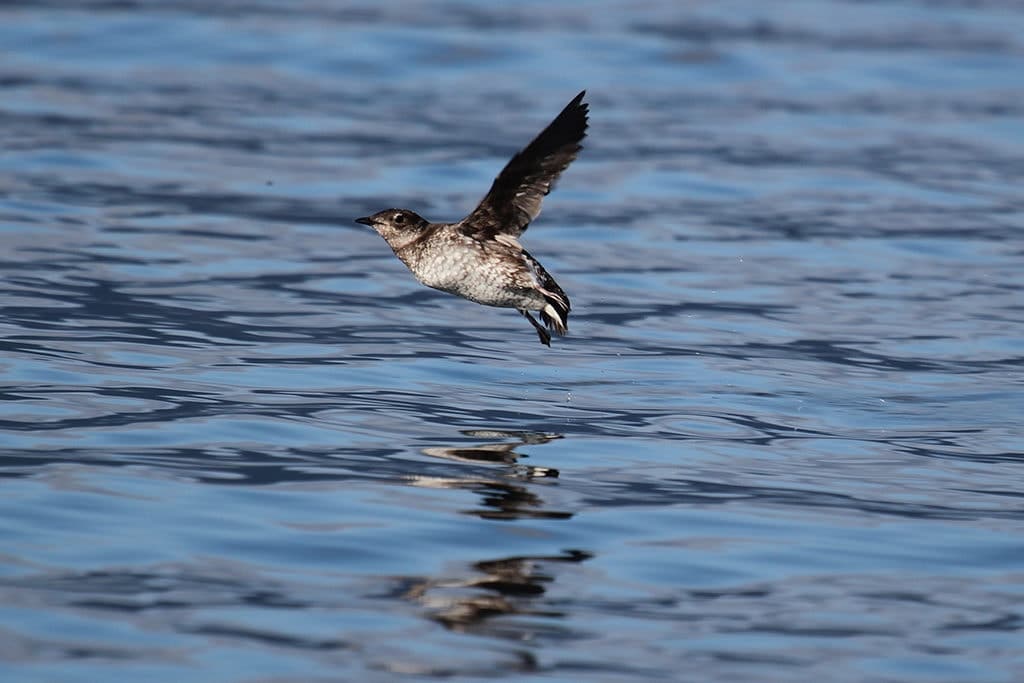
“We applaud the commission for recognizing that the Marbled Murrelet warrants endangered status in Oregon,” said Nick Cady, legal director at Cascadia Wildlands. “This decision sets the stage for the state of Oregon to take the steps that will be necessary to recover this species in Oregon.”
The Marbled Murrelet is a seabird that nests in old-growth and mature forests and forages at sea. Its population has declined dramatically over the decades because of extensive logging in Oregon’s Coast Range. The commission’s decision could have implications for forest protection on state and private timberlands.
“While federal laws have stabilized habitat loss on federal lands, the state of Oregon has continued to allow logging of older forests at an alarming rate and failed to adequately address new threats to the species,” said Bob Sallinger, conservation director for the Bird Alliance of Oregon. “Changing the murrelet’s status to endangered will help ensure that Oregon takes the steps necessary to do its part to save this species.
In response to a petition from multiple conservation organizations, the Oregon Department of Fish and Wildlife developed a status review to assess the murrelet’s condition. The review demonstrated that murrelets need increased protections under the Oregon Endangered Species Act due largely to loss of nesting habitat from ongoing clear-cut logging. State protections are critical, because although many of Oregon’s Coast Range old-growth forests have been logged and converted into industrial tree farms, some of the best remaining older forests occur on state-managed lands.
“We’re pleased commissioners made a sound, science-based decision that’s exactly what these desperately imperiled seabirds need to survive,” said Tierra Curry, senior scientist at the Center for Biological Diversity. “The science was absolutely clear that the murrelet warrants endangered status in Oregon. This protection will be critical to preserving an amazing part of our state’s natural heritage.”
The murrelet was listed as threatened in 1995. However, the recent status review conducted by Oregon’s Department of Fish and Wildlife concluded that the “key threats identified at the time of listing have continued or increased, and many new threats have been identified since the 1990s … the life history exhibited by this species provides little opportunity for the population to rapidly increase even under the most optimal circumstances.”
It also noted that the primary causes of Marbled Murrelet declines — loss and fragmentation of older forest habitat on which the bird depends for nesting — have “slowed, but not halted … since the 1990s,” with greatest losses occurring on lands managed by the state. The review specifically notes that existing programs and regulation have “failed to prevent continued high rates of habitat loss on nonfederal lands in Oregon.”
The Oregon Endangered Species Act requires that the commission adopt survival guidelines for the species at the time of reclassification. Survival guidelines are quantifiable and measurable guidelines necessary to ensure the survival of individual members of the species. Guidelines may include take avoidance and protecting resource sites such as nest sites or other sites critical to the survival of individual members of the species. They would serve as interim protection until endangered species management plans are developed by applicable state agencies and approved by the Fish and Wildlife Commission.
“It is remarkable that this species has been listed as threatened for more than 20 years but the state of Oregon has never developed a plan to actually protect murrelets on either lands owned by the state of Oregon or private timber lands,” said Quinn Read, Northwest director of Defenders of Wildlife.
“The status quo has failed this iconic Oregon seabird. We look forward to working with ODFW and other agencies to developing a plan that will truly protect this species and allow it to recover in Oregon.”
“This is an important step for ODFW. The agency has struggled to faithfully act on it’s core mission of protecting all native fish and wildlife in our state, but with this action to protect the marbled murrelet we hope they have turned the page,” said Steve Pedery, Conservation Director for Oregon Wild.
The conservation groups that initiated the petition to declare the marbled murrelet endangered in Oregon were Cascadia Wildlands, Bird Alliance of Oregon, the Center for Biological Diversity, Oregon Wild, Coast Range Forest Watch and the Oregon Chapter of the Sierra Club.
Contact
- Nick Cady, Cascadia Wildlands | (314) 482-3746 | nick@cascwild.org
- Bob Sallinger, Bird Alliance of Oregon | (503) 380-9728 | bsallinger@auduonportland.org
- Quinn Read, Defenders of Wildlife | (206) 508-5474 | qread@defenders.org
- Tierra Curry, Center for Biological Diversity | (928) 522-3681 | tcurry@biologicaldiversity.org
Founded in 1902, Bird Alliance of Oregon is one of the oldest conservation organizations in the nation. It promotes the understanding, enjoyment and protection of native birds, other wildlife and their habitats through its conservation and environmental education programs, its 150-acre Nature Sanctuary and Nature Store in northwest Portland, and its Wildlife Care Center.
For more information, call 503-292-6855 or visit birdallianceoregon.org.



